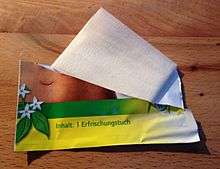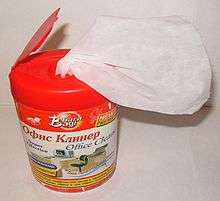Wet wipe
A wet wipe, also known as a wet towel or a moist towelette, or a baby wipe in specific circumstances, is a small moistened piece of plastic[1] or cloth that often comes folded and individually wrapped for convenience. Wet wipes are used for cleaning purposes like personal hygiene and household cleaning.

Invention
American Arthur Julius is seen as the inventor of the wet wipes.[2] Julius worked in the cosmetics industry and in 1957, adjusted a soap portioning machine, putting it in a loft in Manhattan. Julius trademarked the name Wet-Nap in 1958, a name for the product that is still being used. After fine tuning his newfangled hand-cleaning aid together with a mechanic, he unveiled his invention at the 1960 National Restaurant Show in Chicago and in 1963 started selling Wet-Nap products to Colonel Sanders for use in his KFC restaurant.[3]
Production

Ninety percent of wet wipes on the market are produced from plastic textiles made of polyester or polypropylene.[4]
The material is moistened with water or other liquids (e.g., isopropyl alcohol) depending on the applications. The material may be treated with softeners, lotions, or perfume to adjust the tactile and olfactory properties. Preservatives such as methylisothiazolinone are used to prevent bacterial or fungal growth in the package. The finished wet wipes are folded and put in pocket size package or a box dispenser.
Uses
Wet wipes can serve a number of personal and household purposes.[5] Although marketed primarily for wiping infants' bottoms in diaper changing, it is not uncommon for consumers to also use the product to clean floors, toilet seats, and other surfaces around the home. Parents also use wet wipes, or as they are called for baby care, baby wipes, for wiping up baby vomit and to clean babies' hands and faces. [6]
Baby wipes
Baby wipes are wet wipes used to cleanse the sensitive skin of infants. These are saturated with solutions anywhere from gentle cleansing ingredients to alcohol-based "cleaners". Baby wipes are typically different pack counts (ranging up to 80 or more sheets per pack), and come with dispensing mechanisms. The origin of baby wipes most likely came in the mid-1950s as more people were travelling and needed a way to clean up on the go. One of the first companies to produce these was a company called Nice-Pak. They made napkin sized paper cloth saturated with a scented skin cleanser. Rockline Industries of Sheboygan, Wisconsin (which has a large part of the private label wipe market in several segments) went on to be the first to innovate the first baby wipe refill pack and pop-up packs which have become common in the marketplace.[7]
The first wet-wipe products specifically marketed as baby wipes, such as Kimberly-Clark's Huggies wipes and Procter & Gamble's Pampers wipes, appeared on the market in 1990.[8] As the technology to produce wipes matured and became more affordable, smaller brands began to appear. By the 1990s, most super stores like Kmart and Wal-Mart had their own private label brand of wipes made by other manufacturers. After this period there was a boom in the industry and many local brands started manufacturing because of low entry barriers.
Many green-minded parents, or those looking to save extra money, use washable baby wipes, typically small squares of material (cotton, bamboo or fleece) that can be pre-soaked ready to use, or wet as required. Because they do not contain chemicals or artificial fragrances like most disposable wipes, they are gentle on the skin. They are often reported to be more effective at removing solids from the skin because of their textured nature.[9]
Personal hygiene
Wet wipes are often included as part of a standard sealed cutlery package offered in restaurants or along with airline meals.
Wet wipes began to be marketed as a luxury alternative to toilet paper by 2005 by companies such as Kimberly-Clark and Procter & Gamble.[10] They are dispensed in the toilets of restaurants, service stations, doctors' offices, and other places with public use.
Wet wipes have also found a use among visitors to outdoor music festivals, particularly those who camp, as an alternative to communal showers. The wet wipes are a preferable option to the communal facilities, for which there are long queues.
In Southeast Asia, wet wipes are often sold out of refrigerators to give the wipes a refreshingly cool effect.
Cleansing pads
Cleansing pads are fiber sponges which have been previously soaked with water, alcohol and other active ingredients for a specific intended use. They are ready to use hygiene products and they are simple and convenient solutions to dispose of dirt or other undesirable elements.
There are different type of cleansing pads offered by the beauty industry: make-up removing pads, anti-spot treatments and anti-acne pads that usually contain salicylic acid, vitamins, menthol and other treatments).[11]
Cleansing pads for preventing infection are usually saturated with alcohol and bundled in sterile packages. Hands and instruments may be disinfected with these pads while treating wounds. Disinfecting cleansing pads are often included in first aid kits for this purpose. Since the outbreak of H1N1 sales of individual impregnated wet wipes and gels in sachets and flowpacks have dramatically increased in the UK following the Government’s advice to keep hands and surfaces clean to prevent the spread of germs.
Industrial wipes
Pre-impregnated industrial-strength cleaning wipes with powerful cleaning fluid that cuts through the dirt as the high performance fabric absorbs the residue. Industrial wipes has the ability to clean a vast range of though substances from hands, tools and surfaces, including: grime, grease, oil- and water-based paints and coatings, adhesives, silicone and acrylic sealants, poly foam, epoxy, oil, tar and more.[12]
Pain relief
There are pain relief pads sopping with alcohol and benzocaine. These pads are good for treating minor scrapes, burns, and insect bites. They disinfect the injury and also ease pain and itching.
Pet care
Today one can find wet wipes for pet care, for example eye, ear, or dental cleansing pads (with boric acid, potassium chloride, zinc sulfate, sodium borate) for dogs, cats, horses, and birds.
Healthcare
Medical wet wipes are available for various applications. These include alcohol wet wipes, chlorhexidine wipes (for disinfection of surfaces and noninvasive medical devices) and sporicidal wipes.[13] Medical wipes can be used to prevent the spread of pathogens such as norovirus and Clostridium difficile.[14]
Effect on sewage systems
Water management companies ask people not to flush wet wipes down toilets, as their failure to break apart or dissolve in water can cause sewer blockages known as fatbergs.[15][16]
Since the mid-2000s, wet wipes such as baby wipes have become more common for use as an alternative to toilet paper in affluent countries, including the United States and the United Kingdom. This usage has in some cases been encouraged by manufacturers, who have labelled some wet wipe brands as "flushable". Wet wipes, when flushed down the toilet, have been known to clog internal plumbing, septic systems and public sewer systems.[17][18][16] The tendency for fat and wet wipes to cling together encourages the growth of the problematic obstructions in sewers known as "fatbergs".[19][20] In addition, some brands of wipes contain alcohol, which can kill the bacteria and enzymes responsible for breaking down solid waste in septic tanks.[21] In the late 2010s, alternatives such as gel wipe came on to the market to relieve pressure on sewage systems and marine life.[22][23]
In 2014 a class action suit was filed in the U.S. District Court for the Northern District of Ohio against Target Corporation, and Nice-Pak Products Inc. on behalf of consumers in Ohio who purchased Target-brand flushable wipes. The lawsuit alleged the retailer misled consumers by marking the packaging on its Up & Up brand wipes as flushable and safe for sewer and septic systems. The lawsuit also alleged that the products were a public health hazard because they clogged pumps at municipal waste-treatment facilities.[24] Target and Nice-Pak agreed to settle the case in 2018.[25]
In 2015, the city of Wyoming, Minnesota, launched a class action suit against six companies, including Procter & Gamble, Kimberly-Clark, and Nice-Pak, alleging they were fraudulently promoting their products as "flushable".[10] Wyoming dropped the lawsuit in 2018, as there was no proof that it has raised maintenance costs.[26]
In 2016, several British water companies including Wessex Water began a campaign advising consumers not to flush wet wipes down toilets because of the added maintenance costs.[27]
In 2019, the industry body Water UK announced a new standard for flushable wet wipes. Wipes will need to pass rigorous testing in order to gain a new and approved "Fine to Flush" logo. Currently only one product meets the standard.[28]
See also
- Anal cleansing
- Gel wipe
- Oshibori, reusable Japanese wet hand towel
- Washlet, a mechanical alternative to wet wipes
References
- "War on Plastic with Hugh and Anita". the BBC. 18 June 2019.
- "When was the Wet-Nap introduced?".
- Dixler, Hillary (17 June 2016). "A Brief History of the Wet-Nap, Barbecue Sauce's Worst Nightmare".
- Pajda, Aleksandra. "Did You Know Wet Wipes Are Made with Plastic? This Is Why the UK Wants Them Banned". One Green Planet. Retrieved 4 January 2019.
- Rockline, [https://www.rockline.co.uk/products/ Product line
- Horovitz, Bruce (2002-07-11). "More consumers whip out wet wipes". USA Today. Retrieved 16 November 2010.
- "Rockline Europe - Leading European Wet Wipes Manufacturer". Rockline Europe.
- "Historical Journey: An Interactive Timeline". Kimberly-Clark. Retrieved 2013-09-10.
- This study conducted by The University of Manchester has found that baby wipes had an equivalent effect on skin hydration when compared with cotton wool and water.
- Kessler, Matt (October 14, 2016). "Are Wet Wipes Wrecking the World's Sewers?". The Atlantic. The Atlantic Monthly Group. Retrieved 17 October 2016.
- "Acne Myths, Etc. - Are Cleansing Pads Good for Acne?".
- "Supplier of Recycled Wiping Cotton rags, Cleaning rags with bag or box of rag wipers cloth". wipermart.com. Retrieved 2017-06-08.
- "Healthcare Wipes". 30 October 2015.
- "Clostridium Difficile Prevention - C. Difficile Wipes". Pal International. Archived from the original on 10 December 2014. Retrieved 21 November 2019.
- Taylor, Matthew (12 December 2017). "Wet wipes make up 93% of matter causing UK sewer blockages". The Guardian. London.
- Regan, Alex (4 March 2015). "Wet wipes caused sewage flood in garden", Oxford Mail
- Shaver, Katherine (7 September 2013). ‘Flushable’ personal wipes clogging sewer systems, utilities say, The Washington Post
- Stradling, Richard (31 May 2009). "'Flushable' wipes blamed for clogging sewage lines", Seattle Times
- "Oxford 'out-of-control fatberg' threatens homes". BBC News. 1 April 2014.
- "Sewer repairs means 14 days of chaos ahead". Retrieved 8 April 2014.
- Conte, Chris (12 Sept 2013). "Flushable Wipes Creating Messy Septic Issues", Newschannel5.com
- Saat, Siim (25 June 2016). "New Product Development: GEL WIPE by SATU". LinkedIn.
- Kart, Jeff (June 15, 2018). "Toilet Paper Gel Cleans Up No. 2 In More Ways Than One". Forbes.
- Cellini, Lorenzo B.; Tycko & Zavareei LLP (18 April 2014). "Class Action Lawsuit Alleges That Target-Brand Flushable Wipes Are Not Suitable for Flushing and Can Clog Pipes and Damage Sewer and Septic Systems". The National Law Review. Retrieved 19 April 2014.
- "Target Flushable Wipes Class Action Settlement". topclassactions.com. 7 May 2018.
- "City of Wyoming bows out of flushable wipes lawsuit". www.innovationintextiles.com.
- "Water companies declare war on 'flushable' wet wipes". Daily Mail. Press Association. September 20, 2016. Retrieved 17 October 2016.
- https://www.bbc.co.uk/news/business-46835573